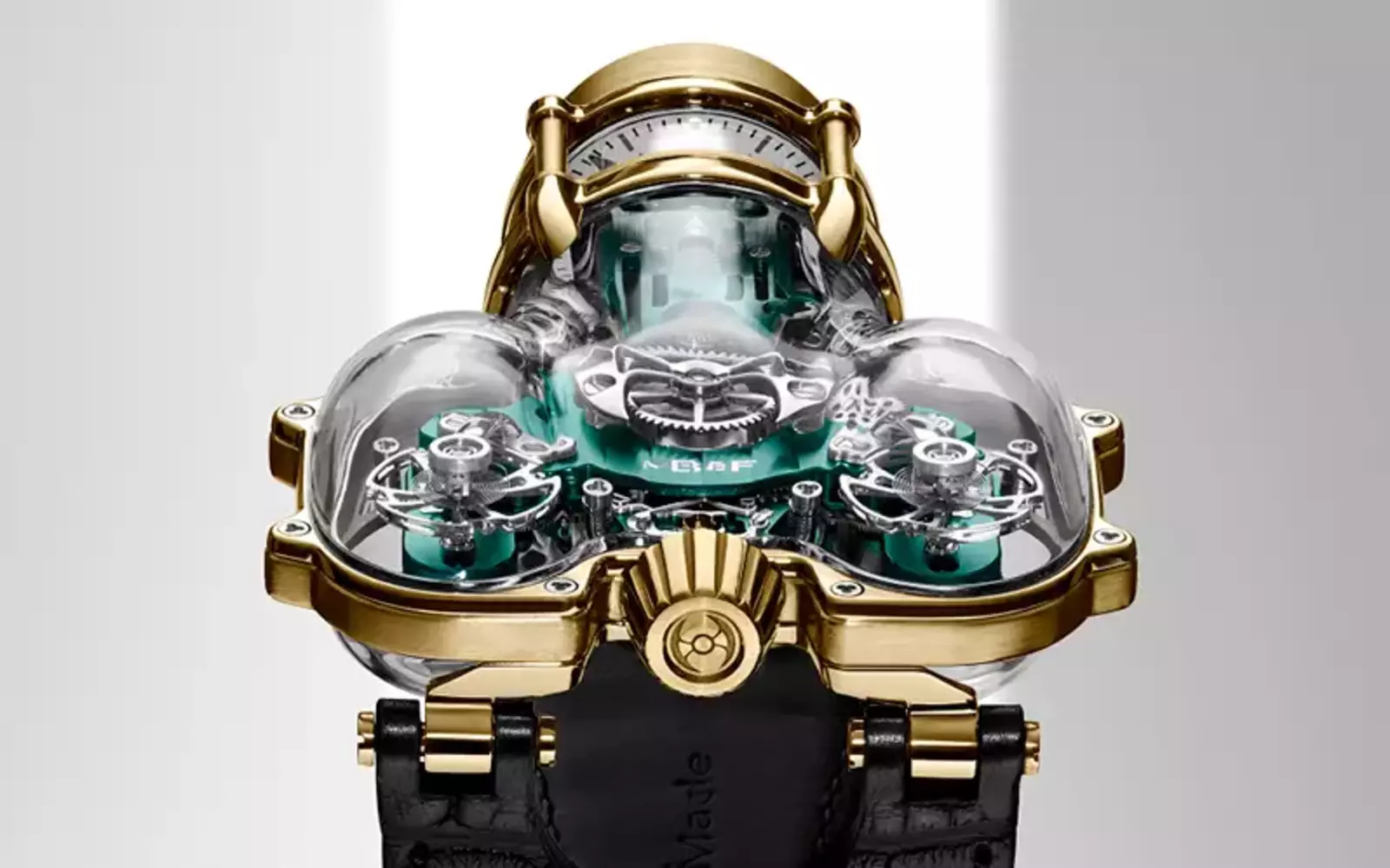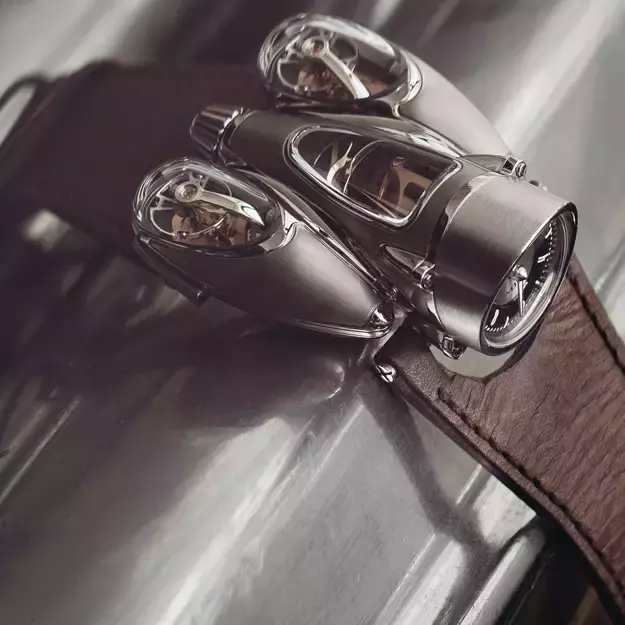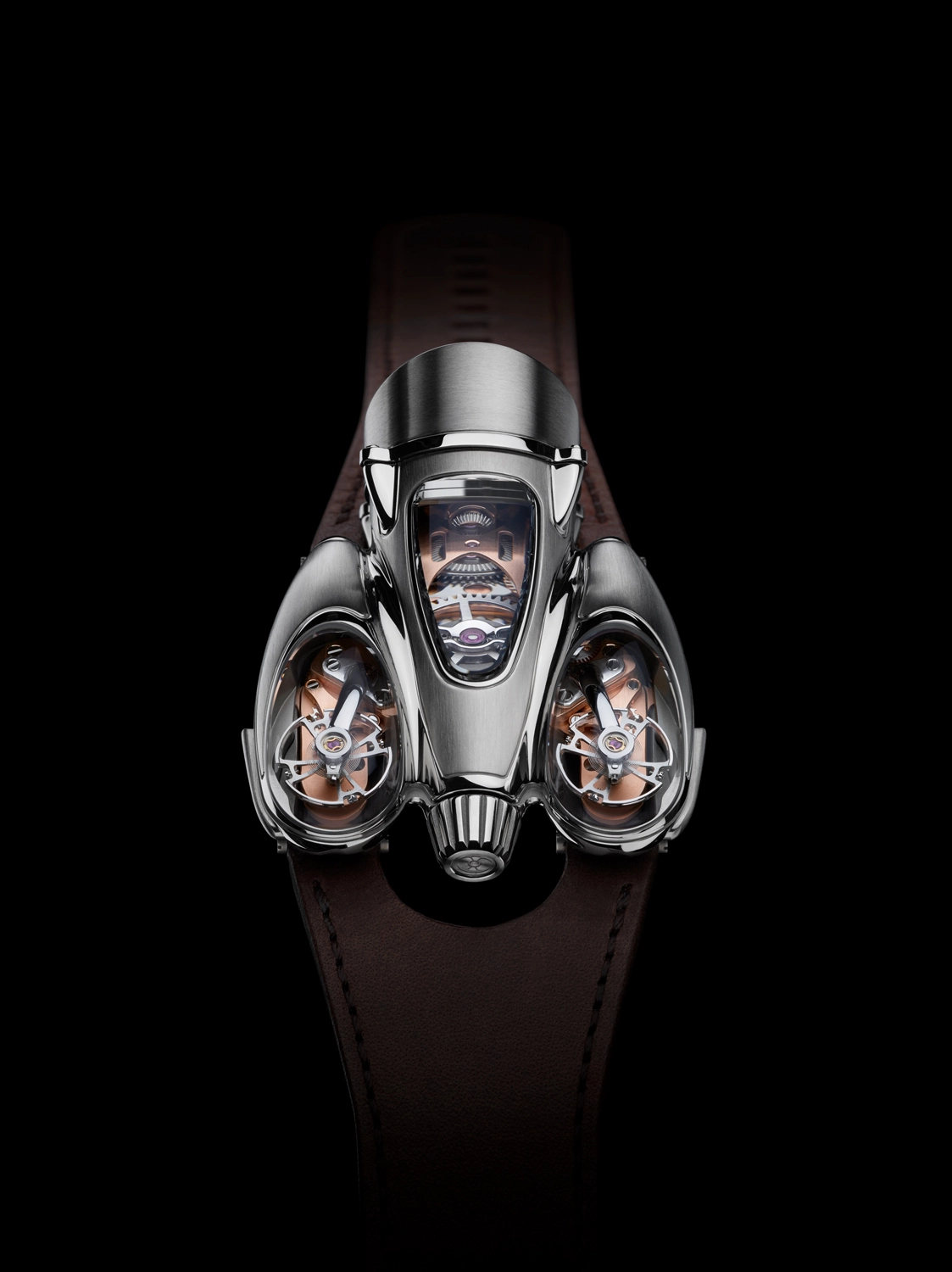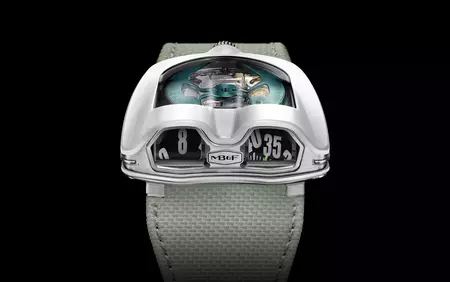
Horological Machine N°9
Flow & Sapphire Vision
In the late 1940s and 50s, aerodynamic principles were just beginning to take root in product design. Curvilinear forms became more prominent, carrying the immediate promise of power and speed – but designers were guided more by their aesthetic sense than by any scientific precepts.
Reminiscent of a jet engine
Inspired by the dynamic profiles of automotive and aviation mid-century design, HM9 Flow treads the path opened by the HM4 Thunderbolt and HM6 Space Pirate, with a geometrically complex combination of sapphire crystal, titanium and gold case elements. But HM9 goes beyond its predecessors, redefining what was thought to be possible in case design.
Reminiscent of a jet engine, the highly complex case encloses an equally complex in-house movement. Twin balance wheels beat independently on each flank of the Machine, while the central body reveals the gearbox of the HM9 engine: a planetary differential that averages the output of both balances to provide one stable reading of the time.
MB&F founder Maximilian Büsser described the engine inside HM9 as “the most beautiful movement we’ve created to date”. What other logical step was there to take, if not to encase the HM9 engine in a transparent sapphire crystal shell? This gave birth to the HM9 ‘Sapphire Vision’ editions – aka HM9-SV.
What's so special about this machine?
A complex “aerodynamic” case, twin balance wheels and a patented 3D-gasket are part of the HM9's incredible appeal.

COMPLEX "AERODYNAMIC" CASE
Reminiscent of a jet engine, the HM9 case is a geometrically complex combination of milled sapphire crystal and grade 5 titanium, red gold or white gold. The extreme curves and acute angles required new manufacturing standards and techniques - especially for the Sapphire Vision editions crafted almost entirely in sapphire crystal.

TWIN BALANCE WHEELS
Fully independent twin balance wheels feed two sets of chronometric data to a central planetary differential for an averaged reading. They are individually impulsed and spatially separated to ensure that they beat at their own independent cadences.

PATENTED 3D-GASKET
The wide-to-narrow alternating arrangement of the three primary volumes of the HM9 case required dividing the case along two axes and devising an unprecedented 3D-gasket for water resistance; a patented innovation, completely novel in its execution throughout the watchmaking industry.
The machine
Reminiscent of a jet engine, the HM9 case is a geometrically complex combination of milled sapphire crystal, 18K gold and grade 5 titanium.
Despite its striking external appearance, MB&F founder Maximilian Büsser described the engine inside HM9 as “the most beautiful movement we’ve created to date”.
- ‘SV’ editions in sapphire crystal with frame in 18K white, yellow or red gold (5N+).
- Grade 5 titanium: ‘Air’ edition with aviation-style dial and NAC-finish movement / ‘Road’ edition with speedometer dial and red gold-finished movement
- 18k 5N+ red gold: ‘Air’ edition with aviation-style dial and NAC-finish movement / ‘Road’ edition with speedometer dial and rhodium-plated movement
- Dimensions: 57 x 47 x 23 mm
- Components: 43 (titanium), 49 (red gold), 52 (SV editions)
- Water resistance: 3ATM (30m); assembled in three segments with patented three-dimensional gasket
- Manual-winding in-house movement
- Two fully independent balance wheels with planetary differential
- Hours and minutes on vertical dial display
- SV editions: Dual spherical propellers under the balance wheels
- Frequency: 2.5Hz / 18,000bph
- 301 components / 52 jewels / 45h power reserve
- Five sapphire crystals treated with anti-reflective coating

Discover the models available for this collection
The result of three years of development, the HM9 engine was created entirely in-house, with the accumulated experience that came with MB&F’s 13 years in existence (in 2018) and previous 14 different movements.
Inspiration
In the post-war years of the late 1940s and 1950s, aerodynamic principles were just beginning to take root in the field of automotive design. The boxy, carriage-like shapes of previous decades were melting into something more streamlined. At the same time, curvilinear forms became more prominent, carrying the immediate promise of power and speed. The sophisticated computer modelling and wind-tunnel technology we have today were far-off dreams at that time – designers were guided more by their aesthetic sense than by any scientific precepts.
The result was some of the most beautiful man-made objects ever created, epitomised by automobiles like the Mercedes-Benz W196 and 1948 Buick Streamliner. Other industries followed, notably that of aviation, producing aircraft such as the sleek-bodied, snub-nosed De Havilland Venom that patrolled Swiss airspace for 30 years.











